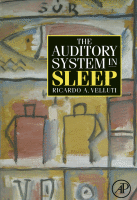Browse content
Table of contents
Actions for selected chapters
- Full text access
- Book chapterAbstract only
CHAPTER 1 - Brief analysis of the organization of the auditory system and its physiological basis
Pages 1-38 - Book chapterAbstract only
CHAPTER 2 - The physiological bases of sleep
Pages 39-77 - Book chapterAbstract only
CHAPTER 3 - Notes on information processing
Pages 79-87 - Book chapterAbstract only
CHAPTER 4 - Auditory information processing during sleep
Pages 89-106 - Book chapterAbstract only
CHAPTER 5 - Auditory unit activity in sleep
Pages 107-149 - Book chapterAbstract only
CHAPTER 6 - Auditory influences on sleep
Pages 151-163 - Book chapterNo access
Conclusions
Pages 165-168 - Book chapterNo access
References
Pages 169-194 - Book chapterNo access
Index
Pages 195-200
About the book
Description
The Auditory System in Sleep presents for the first time a view of a sensory system working in a different state-that of the sleeping brain. The auditory system is always “open” receiving information from the environment and the body itself (conscious and unconscious data). Even during sleep the auditory information is processed, although in a different way. This book draws information from evoked potentials, fMRI, PET, SPECT, lesions, etc., together with electrophysiological online data in order to depict how the auditory system single unit activity, recorded during sleep, revealed the possibility of sensory information participation in sleep processes.
The Auditory System in Sleep presents for the first time a view of a sensory system working in a different state-that of the sleeping brain. The auditory system is always “open” receiving information from the environment and the body itself (conscious and unconscious data). Even during sleep the auditory information is processed, although in a different way. This book draws information from evoked potentials, fMRI, PET, SPECT, lesions, etc., together with electrophysiological online data in order to depict how the auditory system single unit activity, recorded during sleep, revealed the possibility of sensory information participation in sleep processes.
Key Features
- Presents diverse experimental viewpoints from the beginning of classical electroencephalography to the more recent imaging, single units, electro-magneto-encephalography studies, etc.
- Includes classic data as well as new data based in the existing literature and on the long scientific research lines (auditory and sleep) developed by the author and coworkers on this subject since 1963
- Presents diverse experimental viewpoints from the beginning of classical electroencephalography to the more recent imaging, single units, electro-magneto-encephalography studies, etc.
- Includes classic data as well as new data based in the existing literature and on the long scientific research lines (auditory and sleep) developed by the author and coworkers on this subject since 1963
Details
ISBN
978-0-12-373890-5
Language
English
Published
2008
Copyright
Copyright © 2008 Elsevier Ltd. All rights reserved
Imprint
Academic Press
